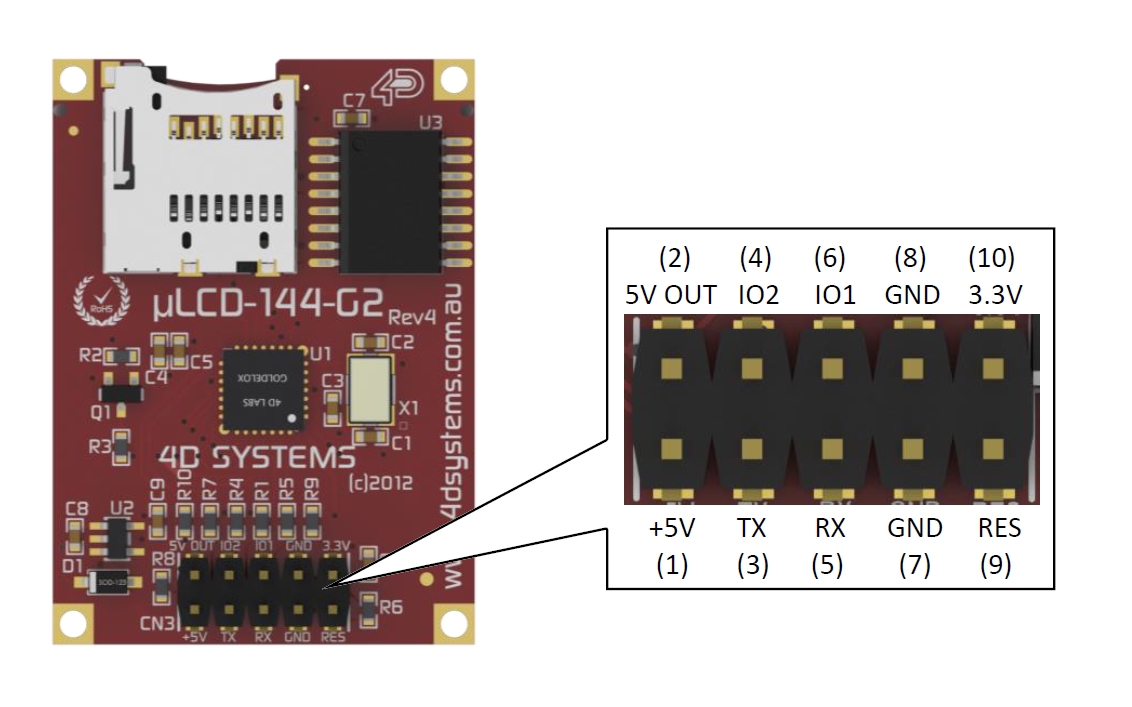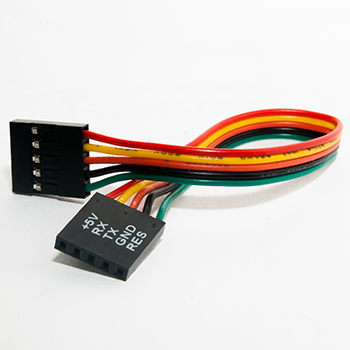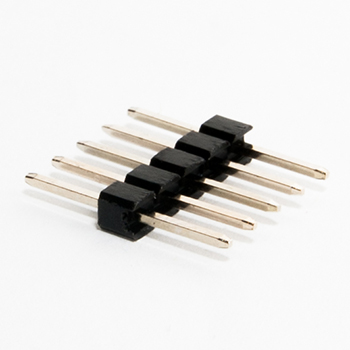Demo of 4DGL library for the uLCD-144-G2 128 by 128 color display. See https://mbed.org/users/4180_1/notebook/ulcd-144-g2-128-by-128-color-lcd/ for instructions
Dependencies: 4DGL-uLCD-SE mbed
Fork of uVGAII_demo by
The uLCD-144-G2 from 4D Systems is a low-cost ($25 qty. 100) smart color LCD display board with a serial interface. They are also available from Sparkfun. It looks like a nice alternative to the now hard to find Nokia 6100 LCD breakout boards. It has a TTL level serial interface and a reset pin. An optional uSD card inserted in the display module's socket can be used to load fonts, images, and play videos in response to serial commands. It has a built in system font and the driver supports the use of printfs, so it is very easy to use and hookup. Here is the wiring for the demo program:
| mbed | uLCD Header | uLCD cable |
|---|---|---|
| 5V=VU | 5V | 5V |
| Gnd | Gnd | Gnd |
| TX=P9 | RX | TX |
| RX=P10 | TX | RX |
| P11 | Reset | Reset |

In the drawing above, the pins are labeled from the LCDs perspective with TX and RX pins. Mbed RX goes to LCD TX and mbed TX goes to LCD RX. So mbed TX goes to the middle pin on the connector which is the uVGA II RX pin. The included cable seen below is plugged into the bottom row of pins and plugged into a breadboard using the male header pins for hookup. Note that on the cable silkscreen seen in the image below RX and TX have been swapped to indicate the connections needed to the microprocessor pins.


// uLCD-144-G2 basic text demo program for uLCD-4GL LCD driver library
//
#include "mbed.h"
#include "uLCD_4DGL.h"
uLCD_4DGL uLCD(p9,p10,p11); // serial tx, serial rx, reset pin;
int main()
{
// basic printf demo = 16 by 18 characters on screen
uLCD.printf("\nHello uLCD World\n"); //Default Green on black text
uLCD.printf("\n Starting Demo...");
uLCD.text_width(4); //4X size text
uLCD.text_height(4);
uLCD.color(RED);
for (int i=10; i>=0; --i) {
uLCD.locate(1,2);
uLCD.printf("%2D",i);
wait(.5);
}
}
Video of longer demo code with both text and graphics. A micro SD card on the LCD module is required for the images and videos seen at the end of the video. The display is actually a bit more colorful and clearer than it appears in the video. Demos include text using printfs, basic graphics commands, a simple bouncing ball animation, computing the Mandelbrot set pixel by pixel, a Plasma wave BLIT, a JPEG image, and a *.wmv video clip.
See https://mbed.org/users/4180_1/notebook/ulcd-144-g2-128-by-128-color-lcd/ for complete info, wiring, breadboard hints on avoiding the use of the cable, and how to work with fonts, images, and videos on the uSD card
main.cpp
- Committer:
- 4180_1
- Date:
- 2013-11-25
- Revision:
- 7:7bd7397ab89f
- Parent:
- 6:f752accd632c
- Child:
- 8:31e63caf37e2
File content as of revision 7:7bd7397ab89f:
//
// TFT_4DGL is a class to drive 4D Systems LCD screens
//
// Copyright (C) <2010> Stephane ROCHON <stephane.rochon at free.fr>
//
// TFT_4DGL is free software: you can redistribute it and/or modify
// it under the terms of the GNU General Public License as published by
// the Free Software Foundation, either version 3 of the License, or
// (at your option) any later version.
//
// TFT_4DGL is distributed in the hope that it will be useful,
// but WITHOUT ANY WARRANTY; without even the implied warranty of
// MERCHANTABILITY or FITNESS FOR A PARTICULAR PURPOSE. See the
// GNU General Public License for more details.
//
// You should have received a copy of the GNU General Public License
// along with TFT_4DGL. If not, see <http://www.gnu.org/licenses/>.
#include "mbed.h"
#include "uLCD_4DGL.h"
//#define SIZE_X 128
//#define SIZE_Y 128
//
uLCD_4DGL uLCD(p9,p10,p11); // serial tx, serial rx, reset pin;
int main()
{
// basic printf demo = 16 by 18 characters on screen
uLCD.printf("\nHello uLCD World\n"); //Default Green on black text
uLCD.printf("\n Starting Demo...");
uLCD.text_width(4); //4X size text
uLCD.text_height(4);
uLCD.color(RED);
for (int i=10; i>=0; --i) {
uLCD.locate(1,2);
uLCD.printf("%2D",i);
wait(.5);
}
uLCD.cls();
uLCD.printf("Change baud rate......");
uLCD.baudrate(600000); //jack up baud rate to max for fast display
//if demo hangs here - try lower baud rates
// printf text only full screen mode demo
uLCD.background_color(BLUE);
uLCD.cls();
uLCD.locate(0,0);
uLCD.color(WHITE);
uLCD.textbackground_color(BLUE);
uLCD.set_font(FONT_7X8);
uLCD.text_mode(OPAQUE);
int i=0;
while(i<64) {
if(i%16==0) uLCD.cls();
uLCD.printf("TxtLine %2D Page %D\n",i%16,i/16 );
i++; //16 lines with 18 charaters per line
}
wait(0.5);
//demo graphics commands
uLCD.background_color(BLACK);
uLCD.cls();
uLCD.background_color(DGREY);
uLCD.circle(60, 50, 30, 0xFF00FF);
uLCD.triangle(120, 100, 40, 40, 10, 100, 0x0000FF);
uLCD.line(0, 0, 80, 60, 0xFF0000);
uLCD.rectangle(50, 50, 100, 90, 0x00FF00);
uLCD.pixel(60, 60, BLACK);
uLCD.read_pixel(120, 70);
uLCD.circle(120, 60, 10, BLACK);
uLCD.set_font(FONT_7X8);
uLCD.text_mode(TRANSPARENT);
uLCD.text_bold(ON);
uLCD.text_char('B', 9, 8, BLACK);
uLCD.text_char('I',10, 8, BLACK);
uLCD.text_char('G',11, 8, BLACK);
uLCD.text_italic(ON);
uLCD.text_string("This is a test of string", 1, 4, FONT_7X8, WHITE);
wait(2);
//Bouncing Ball Demo
float fx=50.0,fy=21.0,vx=1.0,vy=0.4;
int x=50,y=21,radius=4;
uLCD.background_color(BLACK);
uLCD.cls();
//draw walls
uLCD.line(0, 0, 127, 0, WHITE);
uLCD.line(127, 0, 127, 127, WHITE);
uLCD.line(127, 127, 0, 127, WHITE);
uLCD.line(0, 127, 0, 0, WHITE);
for (int i=0; i<1500; i++) {
//draw ball
uLCD.circle(x, y, radius, RED);
//bounce off edge walls and slow down a bit?
if ((x<=radius+1) || (x>=126-radius)) vx = -.90*vx;
if ((y<=radius+1) || (y>=126-radius)) vy = -.90*vy;
//erase old ball location
uLCD.circle(x, y, radius, BLACK);
//move ball
fx=fx+vx;
fy=fy+vy;
x=(int)fx;
y=(int)fy;
}
wait(0.5);
//draw an image pixel by pixel
int pixelcolors[50][50];
uLCD.background_color(BLACK);
uLCD.cls();
//compute Mandelbrot set image for display
//image size in pixels and setup
const unsigned ImageHeight=128;
const unsigned ImageWidth=128;
//region to display
double MinRe = -0.75104;
double MaxRe = -0.7408;
double MinIm = 0.10511;
double MaxIm = MinIm+(MaxRe-MinRe)*ImageHeight/ImageWidth;
double Re_factor = (MaxRe-MinRe)/(ImageWidth-1);
double Im_factor = (MaxIm-MinIm)/(ImageHeight-1);
unsigned MaxIterations = 2048;
for(unsigned y=0; y<ImageHeight; ++y) {
double c_im = MaxIm - y*Im_factor;
for(unsigned x=0; x<ImageWidth; ++x) {
double c_re = MinRe + x*Re_factor;
double Z_re = c_re, Z_im = c_im;
int niterations=0;
for(unsigned n=0; n<MaxIterations; ++n) {
double Z_re2 = Z_re*Z_re, Z_im2 = Z_im*Z_im;
if(Z_re2 + Z_im2 > 4) {
niterations = n;
break;
}
Z_im = 2*Z_re*Z_im + c_im;
Z_re = Z_re2 - Z_im2 + c_re;
}
if (niterations!=(MaxIterations-1))
uLCD.pixel(x,y,((niterations & 0xF00)<<12)+((niterations & 0xF0)<<8)+((niterations & 0x0F)<<4) );
}
}
wait(5);
// PLASMA wave BLIT animation
//draw an image using BLIT (Block Image Transfer) fastest way to transfer pixel data
uLCD.cls();
int num_cols=50;
int num_rows=50;
int frame=0;
double a,b,c=0.0;
while(frame<50) {
for (int k=0; k<num_cols; k++) {
b= (1+sin(3.14159*k*0.75/(num_cols-1.0)+c))*0.5;
for (int i=0; i<num_rows; i++) {
a= (1+sin(3.14159*i*0.75/(num_rows-1.0)+c))*0.5;
// a and b will be a sine wave output between 0 and 1
// sine wave was scaled for nice effect across array
// uses a and b to compute pixel colors based on rol and col location in array
// also keeps colors at the same brightness level
if ((a+b) <.667)
pixelcolors[i][k] = (255-(int(254.0*((a+b)/0.667)))<<16) | (int(254.0*((a+b)/0.667))<<8) | 0;
else if ((a+b)<1.333)
pixelcolors[i][k] = (0 <<16) | (255-(int (254.0*((a+b-0.667)/0.667)))<<8) | int(254.0*((a+b-0.667)/0.667));
else
pixelcolors[i][k] = (int(255*((a+b-1.333)/0.667))<<16) | (0<<8) | (255-(int (254.0*((a+b-1.333)/0.667))));
}
}
uLCD.BLIT(39, 39, 50, 50, &pixelcolors[0][0]);
c = c + 0.0314159*3.0;
if (c > 6.2831) c = 0.0;
frame++;
}
uLCD.cls();
//SD card needed with image and video files for last two demos
while(1){} //remove line, if SD card is used
uLCD.cls();
uLCD.media_init();
uLCD.set_sector_address(0x001D, 0x4C01);
uLCD.display_image(0,0);
wait(10);
while(1) {
uLCD.cls();
uLCD.media_init();
uLCD.set_sector_address(0x001D, 0x4C42);
uLCD.display_video(0,0);
}
}

 4D Systems 128 by 128 Smart Color LCD uLCD-144-G2
4D Systems 128 by 128 Smart Color LCD uLCD-144-G2